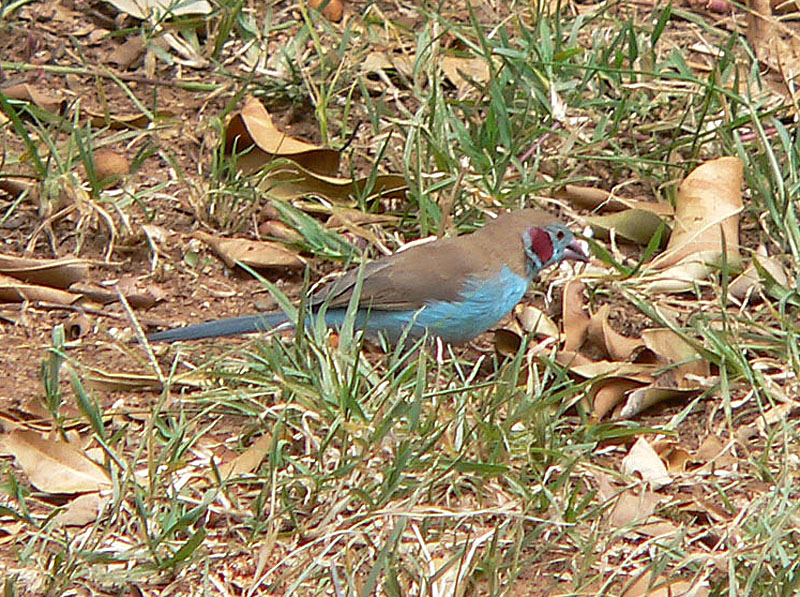Among the130+ species of the family Estrildidae we find popular cage birds and highly endangered species. Some, such as the gorgeously colored Gouldian Finch, are both – at once rare in the wild yet abundant in the pet trade.
 Waxbills and their relatives are often the first finches aviculturists obtain after having gained experience with the hardier zebra or society finches. The black-headed munia and several others are well suited to this role – slightly more sensitive than Zebra Finches, yet robust enough to fare well when given proper care.
Waxbills and their relatives are often the first finches aviculturists obtain after having gained experience with the hardier zebra or society finches. The black-headed munia and several others are well suited to this role – slightly more sensitive than Zebra Finches, yet robust enough to fare well when given proper care.
Natural History
Estrildid finches range throughout Africa, South and Southeast Asia and Australia and, with the exception of a few Australian species, favor warm climates. They range in size from the 3.3 inch long Fernando Po Oliveback to the Java Sparrow or Rice Bird which, due to its stout build, appears larger than its 5.5 inches.
Conservation
While certain Estrildid finches are among the most numerous birds in their habitats, others, such as the Gouldian and several of the parrot finches, are classified as either vulnerable or endangered by the IUCN. The Black-lored Waxbill, known only from a tiny range in southern Democratic Republic of Congo, has not been seen since 1950, and may be extinct.
Keeping Waxbills
 Waxbills, nuns and munias are best housed in large indoor flight cages or, when the weather permits, outdoor aviaries. Warm temperatures are the rule, especially for breeding pairs (they leave the eggs unattended for longer periods than other finches), but healthy birds easily weather occasional exposure to temperatures in the low 50’s (F) if conditions are dry.
Waxbills, nuns and munias are best housed in large indoor flight cages or, when the weather permits, outdoor aviaries. Warm temperatures are the rule, especially for breeding pairs (they leave the eggs unattended for longer periods than other finches), but healthy birds easily weather occasional exposure to temperatures in the low 50’s (F) if conditions are dry.
A covered nest should be included, even for non-breeders, as many Estrildids roost in nests outside of the breeding season.
Most species are gregarious in the wild, and do well in groups in captivity. Mated pairs, however, are best kept alone.
Diet
Although primarily seed eaters that will thrive on a base diet of high quality finch food, Estrildids need a good bit of protein as well. Egg food and softbill food should always be available. Small live mealworms, waxworms, crickets and other insects are preferred however. Canned insects and anole food (dried flies) are often well-accepted also.
Grit and cuttlebone should be available at all times.
Breeding Estrildid Finches
A number of species, especially the more popularly-kept munias and nuns, will breed readily in captivity if provided with ample room and quiet surroundings. Tri-colored Nuns and other long-kept species are best suited for ones first attempts at breeding Estrildid finches.
All species studied thus far construct covered nests, and many roost in these even when not raising chicks. Protein requirements soar during the breeding season – the provision of additional protein, especially in the form of live insects, is also useful in bringing finches into reproductive condition.
Further Reading
For specific information on individual Estrildid finches, please Introducing Nuns, Munias and Mannikins and The Common Waxbill.
I’ll cover the care of individual finch species in the future.
Gouldian Finch image referenced from wikipedia and originally posted by Kjacques
 That Bird Blog – Bird Care and History for Pet Birds
That Bird Blog – Bird Care and History for Pet Birds

 Gouldian finches require more room than similarly-sized finches…there is some evidence that cramping may lead to metabolic disorders. Please provide yours with a
Gouldian finches require more room than similarly-sized finches…there is some evidence that cramping may lead to metabolic disorders. Please provide yours with a